In the March 2018 issue, Dimitri Musafia and Glenn Wood examine a template that apparently proves that instrument cases were made in Stradivari’s workshop. In this article from April 2008, Musafia looks at the cases used to house Stradivari violins, while Wood gives an overview of Italian cases
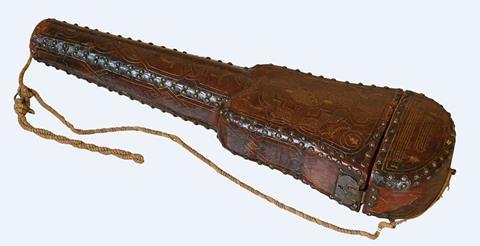
Part 1: Although much is known about Stradivari’s instruments, it is not generally realised that the workshop also produced accessories for the instruments that it made, including cases – about which we know very little, writes Dimitri Musafia
Today’s violin makers would never dream of making cases for their instruments: not only is modern case-making a highly specialised field, but it’s far easier and cheaper for today’s luthiers to purchase ready-made cases from one of the many manufacturers worldwide than to make the cases themselves.
In the 17th and 18th centuries, communications and transportation were much slower and less efficient than they are today, and successful violin making workshops were for the most part well staffed and had relatively high outputs, certainly when compared with the single-maker workshops that are the vast majority in Cremona today. Since labour was cheap and raw materials were abundant, it made much more sense for a violin making workshop to produce its own accessories rather than to order them from elsewhere.
Stradivari’s workshop was world-renowned even in its own time, and its instruments were commissioned by the rich and famous. It is logical to assume that Stradivari would have provided only the best cases for his instruments, which often had to undertake long, perilous journeys before they reached the hands of the new owner. Since Stradivari was a perfectionist, it would also be logical to assume that he would have had the final word in how the cases were to be made in order to ensure the instruments’ safe delivery.
Thus it comes as no surprise that the Museo Stradivariano in Cremona exhibits drawings, sketches and designs by Stradivari himself representing components of the violin cases as he wanted them: locks, latches, hinges and other details, including no less than 52 different keyhole designs. These autograph drawings, some of which are published in Simone F. Sacconi’s book The Secrets of Stradivari, came from Stradivari’s estate and were sold by his sons Francesco and Omobono to Count Cozio di Salabue before eventually ending up in the museum. Not only do these designs give us further insights into the multifaceted genius of the great luthier, but they also lend further credibility to the theory of researcher and violin case expert Glenn Wood (see panel below), who hypothesises that as Stradivari perfected the violin with the famous G pattern (which he used from 1710 until his death in 1737), he may also have invented the modern, hinged-top violin case, the direct descendants of which violinists use today.
Whereas violins themselves have remained substantially the same, violin cases have evolved considerably over the centuries to meet the challenges posed by changes in society. Cases in the 18th century reflected the fact that travel was rarer than it is now. When examining them it is immediately apparent that they were not intended to be practical in the modern sense of the term. Usually weighty and with rather uncomfortable, ornate metal handles, these cases don’t seem to encourage everyday use but nevertheless do provide safe places to keep the violin in the home environment and during an occasional trip in a horse-drawn carriage, bumped along with the owner’s other trunks and luggage.
Italian violin cases of the 17th and 18th centuries are generally made of poplar, which is abundant in the Italian Po valley region, lightweight and widely used locally for cabinet making. They tend to have been carved from a solid block rather than bent or formed like German or English cases of the time. To avoid warping, it would have been necessary to use well-seasoned wood – another certain indication of cost being no object. The resulting structure is relatively heavy and cumbersome, but of great strength.
The case shown here is possibly one of the earliest attributed to Stradivari. Its tapered design – known as the ‘holster’ case design and pretty much the standard of the time for those cases intended to be portable – has the wider extremity hinged to allow the violin and the bow, presumably wrapped in a cloth bag, to be inserted by sliding them in scroll- and tip-first.
The exterior of this case is covered in calfskin, which is glued to the structure and then finished with 369 metal studs placed roughly every 2.5cm along the edges of the case to protect them. The surface is richly decorated with motifs that were first applied in gold leaf and then pressed into the leather with heated brands. The symmetry of the design is so exacting that we can presume the work was done with a half-template. This precision is in curious contrast with the rather casual placement of the protective studs, a contrast which lends further credence to the idea that multiple hands created this work. Indeed, this kind of leather decoration was at the time an almost exclusive speciality of bookbinders, whose skill in this work had reached considerable perfection: the woodwork and leatherwork may thus have been done independently of each other.
Among the exterior decorations is a melody with Italian text that reads: Ecco la cetra e dia principio al canto (‘Here’s the lyre and let the song begin’). So far it has not been possible to link this text to any known musical work.
Of greatest interest, however, is the inscription STRADIVARIO A. CRE. on both sides of the hinged opening, which not only confirms that this case is connected to the great luthier’s workshop, but also gives a clue as to its period of construction.
In the colloquial vernacular of the day, the name ‘Stradivari’ (plural) could also have been expressed in the singular form, ‘Stradivario’ (this was before the plural form became the standard for Italian surnames). Indeed, the latinised ‘Stradivarius’ derives from the singular form, rather than from the plural.
According to a lecture given by restorer–researcher Andrew Dipper, the name Stradivari in fact appears as ‘Stradivario’ in some documents until around 1669, although the extra ‘o’ occasionally persisted until 1680, as can be seen handwritten by Stradivari himself on the inside of a mandolin of that year. This may mean that the case was made no later than that time, when Antonio was in his 20s or 30s. The ‘A.’ and ‘CRE.’ follow the rather arbitrary abbreviation practice of the time.
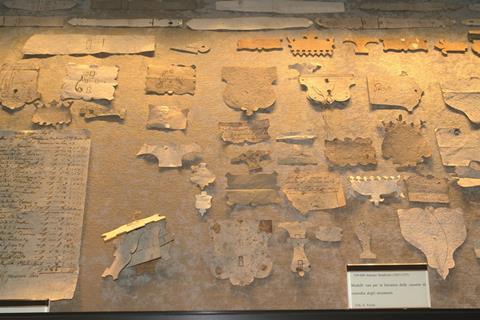
The Museo Stradivariano displays two relics that contain the name Stradivario: the B form template, which has the handwritten annotation F.B. di Ant.o Stradivario, and a template for the construction of a lute, which has the handwritten annotation Ant. Stradivario/ Liuto alla francese. Likewise, the Civic Library of Cremona houses a document in which the following text appears: Si ha per fama non esservi presentemente nel mondo piu’ perito artefice d’istrumenti musicali del Stradivario da Cremona.
However his name was spelt, there is a lack of hard evidence regarding Stradivari’s first years of activity. Researcher Carlo Chiesa believes that Stradivari served only a brief apprenticeship (if he served one at all) in the Amati workshop before starting out on his own, some time between 1666 and 1670 – around the time that this case may have been made. His first instruments weren’t made with top-quality wood, which would seem to indicate that, at least in the beginning, the young Antonio didn’t have an elite clientele. Researcher Toby Faber, in his book Stradivari’s Genius: Five Violins, One Cello, and Three Centuries of Enduring Perfection, suggests that at that time he may have been moonlighting as a woodcarver and inlayer, just to make ends meet. Yet this is a luxurious and costly violin case, undoubtedly made for an important customer: could it have represented a turning point in his career?
Unfortunately, it has been so far impossible to identify Stradivari’s influential customer through the coat of arms that graces the exterior of this case. It is true that each aristocratic family had its own symbol, but at that time in Italy there were growing numbers of new noble families, and family crests were plentiful, making it difficult sometimes to put a name to a crest.
How the gold-leaf decoration was used
- The painstaking procedure necessary to create the rich, precise gold-leaf decoration in the leather covering the case was a speciality of bookbinders and is known by only a handful of people today.
- The calfskin covering was applied to the wooden shell with heated animal glue. First the side panels were applied, then the top and bottom panels, with the edges overlapping. Thin and resilient leather provided the best results.
- A paper pattern was used to draw the design, with a follow-the- number code to specify which leather iron (actually made of bronze) would be used where. Bookbinders often had thousands of irons, but if a customer desired his own, such as for a family crest, they would be ordered from a goldsmith. The design’s symmetry was ensured by folding the paper pattern down the centre-line.
- Before applying the gold leaf, a gluing mixture was prepared by beating egg whites and vinegar into a froth and letting the solution sit for a day, then filtering it to remove impurities.
- The gluing mixture was applied by brush to the leather, reproducing the design of the decoration. Two coats were applied, occasionally with the addition of almond oil.
- The gold leaf was then carefully applied to the gluing mixture.
- The leather irons, heated to the correct temperature, were pressed on to the gold leaf, making it adhere in the areas receiving pressure. The irons had to be heated to exactly the right temperature: too hot, and the gold leaf would burn; too cool, and it wouldn’t adhere.
- A rag was used to wipe away the excess gold leaf, and subsequently burnt to retrieve the gold.
- The final finish was provided by a lacquer, applied to preserve both the leather and the applied gold-leaf pattern.
Despite the beauty and workmanship of this holster case, as well as the practicality of its relative lightness and compact dimensions, the design itself is clearly flawed. Since the interior of such cases were usually lined with just paper (although many were modified by relining with cloth, as this one has been), sliding the instrument into it caused abrasions to the back and scroll, especially wearing down the edges of the latter, as can so often be seen on instruments of the period.
In this particular example, the bow would simply have been inserted haphazardly with the violin. It would thus have been in direct contact with the instrument and free to bang against it. Proper accommodation for bows appears only around 1701.
Just as these defects are obvious to us today, they must also have been obvious to Stradivari the perfectionist. This may, as Wood suggests, have prompted him to redesign his cases completely in order to address better the issue of instrument safety.
We will never know for sure if this case was truly made in the Stradivari workshop, but whether it was made by Stradivari personally or just commissioned by him really makes little difference. It is accepted that a good portion of the instruments ascribed to Stradivari were at least in part built by his assistants: in the same way, the most exclusive haute couture designer gown today is stitched by anonymous seamstresses and not by the designer whose name goes on it. That the woodworking was done in the Stradivari workshop, and the leatherwork done outside, perhaps by the then flourishing bookbinders, is an enticing possibility – although Stradivari’s estate did include leatherworking tools for case making.
The last attic-find violin that turned out to be a genuine Stradivari was discovered decades ago, but the chances are that there are still many opportunities to discover a ‘new’ Stradivari, albeit one of his violin cases. It is possible for a master case maker to leave as many clues to their identity as a master violin maker.
Part 2: Glenn Wood gives an overview of Italian violin cases, arguing that it was Stradivari who established the model from which all modern cases are derived
No violin by Stradivari has bow-damage on its belly. The same cannot be said of violins by Guarneri ‘del Gesù’ and the lesser Italian makers of the 17th and 18th centuries. One possible reason for this is that Stradivari perfected the style of case still used today in which the violin and bow are kept safely apart through the use of a hinged lid.
Although cases from 1650–1780 are much rarer than violins from the same period, the few that survive seem to fall into two basic categories: the ‘holster’ case (so named because of its similarity to a gun holder) and the ‘top loader’. The former are shown in 17th-century engravings of musical instruments, and the latter predominate in the 18th century – so the transition must have taken place during Stradivari’s lifetime.
A typical holster configuration is illustrated in figure 1. The wide end is hinged so that the violin can be slid inside scroll-first, followed by the bow (figure 2 clearly shows the groove intended to guide the bow home after inserting the violin). Inevitably, this resulted in an unsightly scar on the belly to the right of the fingerboard. The ‘Cannon’ Guarneri ‘del Gesù’ (1743) is a good example of a violin showing bow damage as a result of being kept in a case such as this.
The case illustrated in figure 3 ensures that gravity keeps the instrument in the lower part of the case while some basic holders retain the bow or bows in the lid section. Although no proofcurrently exists that this case came from the Stradivari workshop, such cases are generally accepted as being Cremonese and are usually dated to the early 18th century.
Another case from the same workshop (figure 4), which still has its original lock latch, provides additional evidence of the extraordinary effort and expense lavished on such cases.
We know from the assortment of designs in the collection of Stradivari artefacts in Cremona that the maker designed locks and hardware for cases – but did he actually make them? Sacconi, in the section on tools in his book The Secrets of Stradivari, notes that Stradivari had in his workshop eight iron tools for cutting and working the leather for covering instrument cases.
When one looks at the variety of materials (leather, wood and metal; paper and cloth for linings) and skills required to make one of these cases, the time and cost involved in its manufacture can hardly have been less than for those required for a violin. For example, each hinge in the case in figure 4 was beaten from wrought iron, measures 37 inches long and completely encircles the case.
One way of dating these cases would be to examine their paper lining. Without being told anything of the origin or location of the paper shown in figure 5, found in the case illustrated in figure 4, paper expert Kathleen Orlenko has identified it as Italian, c.1730.
All this indicates that these leather-covered cases were conceived by an Italian violin maker in the early 18th century with an obsessive wish that his instruments should be fully protected, in transit and in use, and that no expense should be spared in their construction. Antonio Stradivari fits that profile.
























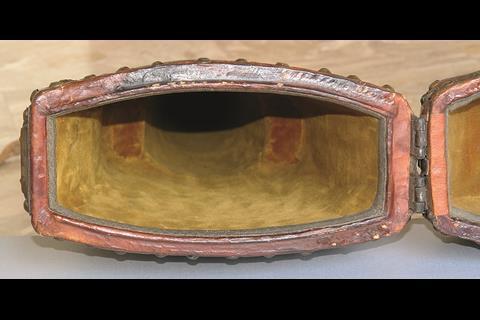


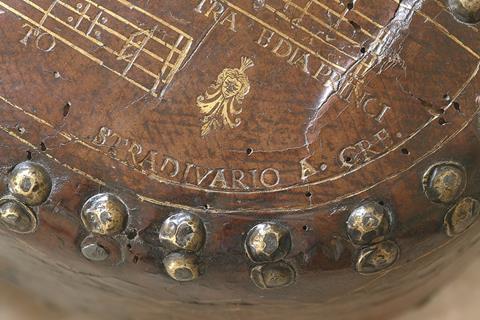
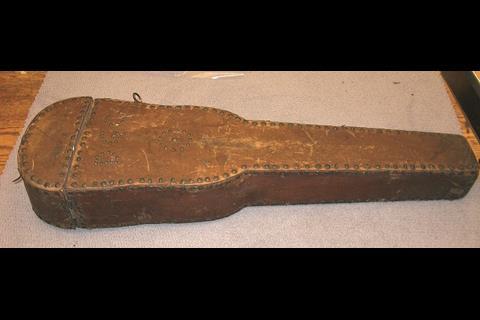
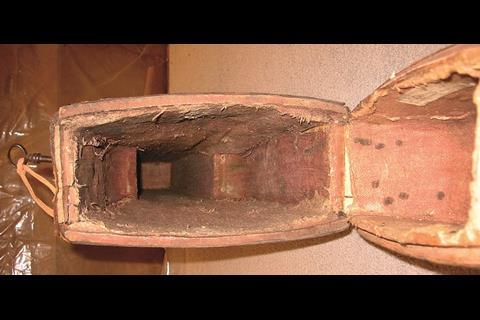
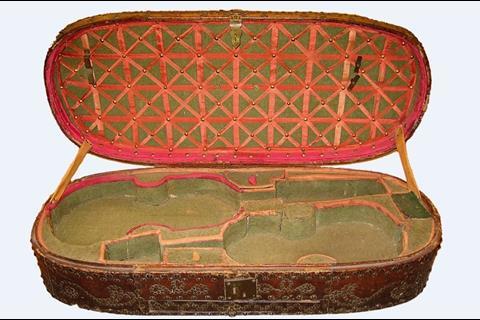
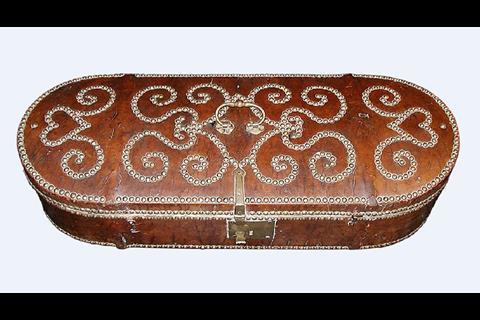
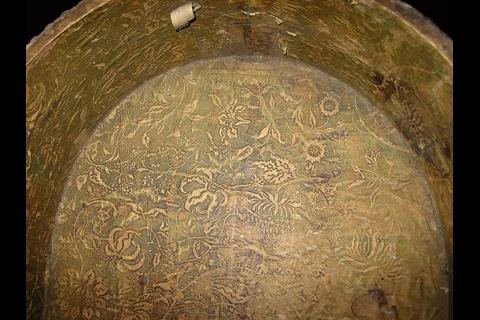












No comments yet